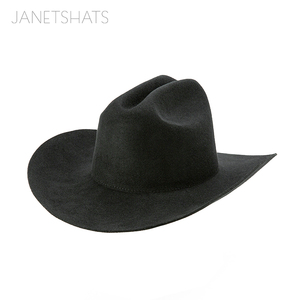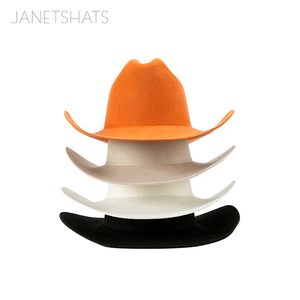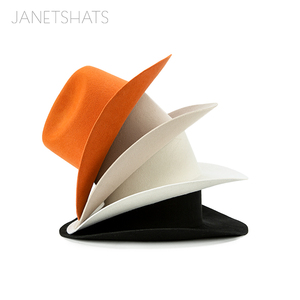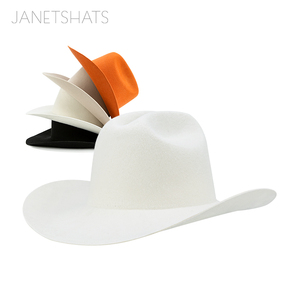
All categories
Featured selections
Trade Assurance
Buyer Central
Help Center
Get the app
Become a supplier

(11 products available)




















































Felt hat stiffeners come in different types, each designed to achieve specific results depending on the hat's material and the desired stiffness level. Here are some common types of felt hat stiffeners:
Spray Starch
Spray starch is a convenient and easy-to-use stiffener for felt hats. It comes in an aerosol can and is sprayed directly onto the hat. Once it dries, it provides a moderate level of stiffness that helps maintain the hat's shape. Spray starch is suitable for daily use and can be easily washed out if needed. It's ideal for soft felt hats that require a little extra structure without becoming too rigid.
Liquid Starch
Liquid starch is another effective stiffener for felt hats. Unlike spray starch, it is applied with a brush or by soaking the hat in a mixture of liquid starch and water. Once it dries, it offers a firmer hold than spray starch, making it suitable for hats that need more structure. Liquid starch is often used for homemade hat stiffeners and can be adjusted by altering the concentration of starch and water.
Gelatin Stiffener
Gelatin stiffeners are popular for creating a rigid structure in felt hats. Powdered gelatin is mixed with warm water to form a solution that is applied to the hat. Once it dries, the gelatin bonds the fibers together, providing a firm hold. This method is particularly effective for creating structured, boxy hats. Gelatin stiffeners are temporary and can be washed out, making them ideal for hats that change shape frequently.
Commercial Felt Hat Stiffeners
These are specially formulated products designed specifically for stiffening felt hats. They come in liquid or spray form and provide excellent results without damaging the hat. Commercial stiffeners are suitable for various felt types and offer different stiffness levels depending on the product. They are a reliable option for maintaining the shape and structure of felt hats over time.
PVA Glue Stiffener
PVA glue, or polyvinyl acetate, is a common adhesive that can also be used as a stiffener for felt hats. When mixed with water, it creates a solution that bonds the hat's fibers and provides a firm, long-lasting hold. PVA glue is readily available and easy to use, making it a popular choice for many hat makers and enthusiasts. One of the benefits of using PVA glue as a stiffener is its versatility. It works well on various materials, including felt, fabric, and paper, making it a handy addition to any crafting toolkit. However, it's important to note that PVA glue is not waterproof, so hats treated with this stiffener may not hold up well in wet conditions.
Felt hat stiffeners are available in many forms, and each type is designed to meet a specific need. Here are some of the most common types:
Liquid Stiffeners
Liquid felt hat stiffeners are applied to the hat in liquid form. They penetrate the fibers of the felt and create a rigid structure. This type of stiffener is excellent for achieving a moderate level of stiffness. It is easy to apply and can be adjusted based on the amount used. Liquid stiffeners are water-based or solvent-based.
Aerosol Stiffeners
Aerosol felt hat stiffeners come in spray cans. They provide an even coating that dries quickly. Aerosol stiffeners are great for achieving a firm hold. They are convenient and easy to use. They are ideal for touch-ups and quick applications. They are used by both professionals and casual hat wearers.
Sheet or Fabric Stiffeners
Sheet or fabric felt hat stiffeners are applied as a material. They can be adhesive or non-adhesive. These stiffeners are excellent for structural support. They are used in the crown and brim of the hat. They offer consistent stiffness across the areas. They are preferred for custom hat making.
Gel Stiffeners
Gel felt hat stiffeners are unique. They offer a flexible hold. This allows the hat to retain some shape. They are ideal for soft felt hats. They are easy to apply and dry clear. They are perfect for maintaining a natural look.
Paste Stiffeners
Paste felt hat stiffeners are traditional. They offer a strong hold. They are applied with a brush. They penetrate the fibers of the felt. They work well for structured hats. They dry to a firm finish and keep the hat in shape.
Powder Stiffeners
Powder felt hat stiffeners are unique. They are applied as a powder. They are absorbed by the felt. They provide a firm structure. They are ideal for custom applications. They allow for precise control over stiffness. They are used by hat makers and designers.
Felt hat stiffeners are usually used to give the felt hats a firm and stiff structure. However, the stiffener also has the ability to blend in with the overall design of the outfit. Below are some ways in which felt hat stiffeners can be worn or matched to different outfits:
Formal Occasions
For formal occasions, one should opt for a stiffened felt hat that is classic in style, for example, a fedora or a trilby. These hats should be paired with formal attire such as a dark suit or tuxedo. The stiffener provides the hat with a proper and neat appearance that is desirable for formal settings. In addition, the hat should be worn with a stiffener that is clear or water-based, which will not alter the color of the felt but rather enhance its texture. This type of stiffener is ideal for maintaining the hat's shape throughout the event.
Causal Occasions
During casual occasions, felt hats such as panama or cowboy hats should be worn and paired with casual outfits. For example, a pair of jeans and a T-shirt. A flexible or spray-on hat stiffener should be used on the hat, which will enable the wearer to achieve a comfortable yet structured look. The casual setting allows more flexibility in terms of the type of stiffener used, as one can experiment with different textures and levels of stiffness without compromising style.
Vintage Look
If one is looking for a vintage look, a felt hat stiffener can be used to achieve this. Hats such as cloches or boater hats should be worn and paired with retro-inspired clothing. In addition, a strong or gel-based hat stiffener should be used to ensure that the vintage hats maintain their shape. The vintage look requires a more rigid structure to achieve the desired style, and a strong stiffener will provide this.
Sunny Days
On sunny days, a felt hat stiffener should be used to help the hat maintain its shape and provide protection from the sun. Wide-brimmed hats such as sun hats or bucket hats should be worn and paired with lightweight fabrics. For this case, a spray-on or liquid hat stiffener should be used, which will ensure the hat is well shaped and able to provide shade from the sun. The stiffener also helps the hat maintain its structure throughout the day, making it a practical choice for sunny weather.
Q1: How does stiffener felt hat work?
A1: The stiffener for felt hats works by penetrating the fibers of the felt and bonding them together. This process increases the structural integrity of the felt material, making it firmer and more resilient. Depending on the type of stiffener used, the effect can be either temporary or permanent. Water-based stiffeners dry to a firm finish, while spray adhesives provide a quick fix that can be adjusted before setting completely.
Q2: Can one use starch as a stiffener for a felt hat?
A2: Starch is an effective and economical stiffener for felt hats. It produces a crisp, firm texture that is suitable for most casual applications. Simply dissolve the starch in hot water, allow it to cool, and soak or spray it onto the felt. Once dry, the hat will hold its shape well. However, for long-term results, commercial hat starches or other synthetic stiffeners may be preferable, as they offer greater durability and resistance to moisture.
Q3: Is it possible to make a felt hat softer after using a stiffener?
A3: Soften a stiffened felt hat by applying fabric conditioner or soaking it in a mixture of water and vinegar. This process may loosen the stiffening agent and relax the fibers of the felt. However, the effectiveness of this method depends on the type of stiffener used. Some synthetic stiffeners create a permanent bond that is difficult to reverse, while others may yield more readily to softening agents.